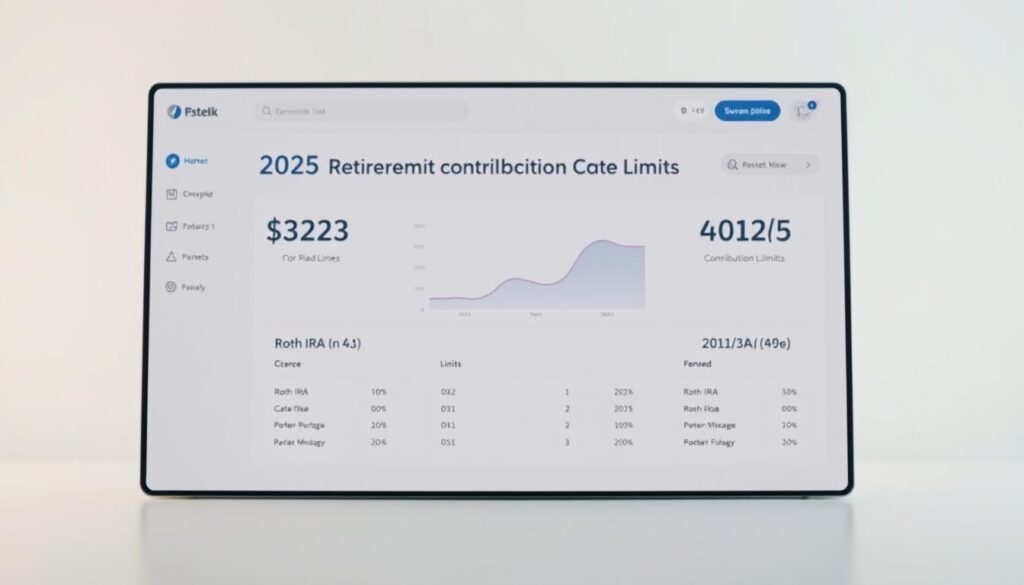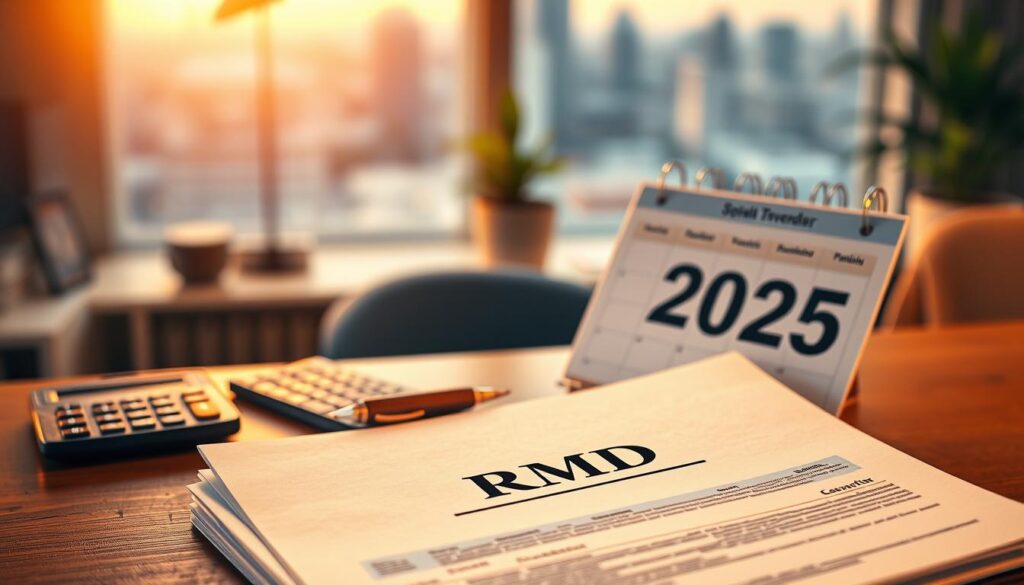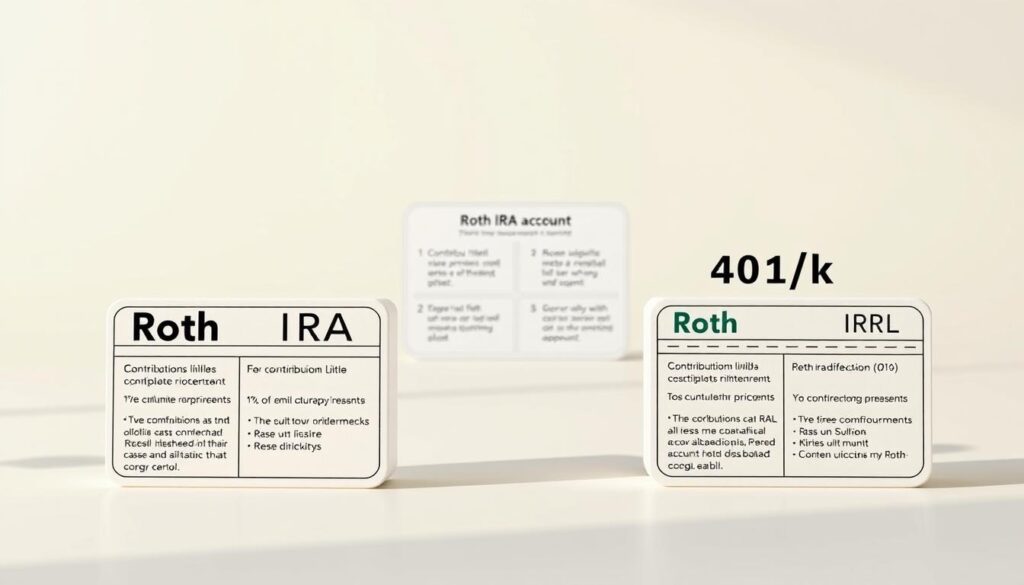Planning for the future is more important than ever. With changing tax laws and economic shifts, choosing the right savings plan can make a big difference. Understanding your options helps secure financial stability.
The decision between a Roth IRA and a 401(k) depends on your income, age, and goals. Each offers unique benefits, from tax advantages to employer matching. The SECURE Act 2.0 also brings new rules that could affect your choice.
This guide breaks down the key differences so you can decide what works best for you. Whether you prioritize flexibility, tax-free withdrawals, or employer contributions, knowing the details ensures smarter planning.
Key Takeaways
- Retirement planning in 2025 requires careful consideration of tax laws and economic factors.
- Both Roth IRA and 401(k) plans offer distinct advantages based on your financial situation.
- Recent changes under the SECURE Act 2.0 may impact contribution limits and withdrawal rules.
- Employer benefits, income level, and long-term goals influence the best choice for you.
- Flexibility and tax treatment are critical factors when comparing these retirement accounts.
Introduction to Roth IRA and 401(k) Plans
Not all retirement accounts work the same way. Two popular options—Roth IRA and 401(k)—offer different tax benefits and rules. Picking the right one depends on your income, timeline, and financial goals.
What Is a Roth IRA?
A Roth IRA is a personal savings account funded with after-tax dollars. You pay taxes now, but withdrawals after age 59½ are tax-free if the account is at least five years old. This makes it ideal for those expecting higher taxes later.
For 2025, income limits apply. Single filers earning over $165,000 (or $246,000 married) face phase-outs. Unlike a 401(k), contributions aren’t tax-deductible, but earnings grow tax-free.
What Is a 401(k)?
A 401(k) is an employer-sponsored plan with pre-tax contributions. Your taxable income reduces now, but you’ll owe taxes on withdrawals. Many employers match contributions, boosting your savings. The 2025 limit is $23,500, with catch-up options for those 50+.
Funds are deducted from your paycheck automatically. Early withdrawals before 59½ may trigger penalties, except in special cases like hardship exemptions.
| Feature | Roth IRA | 401(k) |
|---|---|---|
| Tax Treatment | Tax-free withdrawals | Tax-deferred growth |
| Income Limits (2025) | $165K single / $246K married | None |
| Employer Match | No | Yes (up to IRS limits) |
Both accounts help secure your future, but their structures cater to different needs. A Roth IRA suits those prioritizing tax-free growth, while a 401(k) offers immediate tax breaks and employer perks.
Roth IRA vs. 401(k) in 2025: Key Differences
Tax advantages and access rules set these retirement plans apart. Your choice impacts your paycheck today and savings tomorrow. Here’s how they compare.

Tax Treatment: Now vs. Later
A traditional 401(k) cuts your current taxable income. You’ll pay taxes later upon withdrawal. A Roth IRA flips this: contributions use after-tax dollars, but withdrawals are tax-free.
Example: If you earn $60,000 and contribute $5,000 to a 401(k), your taxable income drops to $55,000. With a Roth, you pay taxes on the full $60,000 now but lock in tax-free growth.
Eligibility and Access
Roth IRAs have income limits ($165,000 single/$246,000 married in 2025). Earn more, and you’re phased out. A 401(k) has no income restrictions—anyone with an employer-sponsored plan can join.
Access differs too. Roth IRAs let you withdraw contributions (not earnings) penalty-free anytime. Most 401(k)s restrict access until age 59½, barring hardships.
Employer Matching (401(k) Exclusive)
Only 401(k)s offer employer matches—free money! In 2025, SECURE 2.0 allows matches to go into Roth accounts (taxed upfront). The average match is 3–6% of your salary.
- 2025 Contribution Limits: $23,500 for 401(k)s ($30,500 with catch-up). Roth IRAs cap at $7,000 ($8,000 if 50+).
- Payroll Perks: 401(k)s deduct automatically from your paycheck, making saving effortless.
Tax Implications: Roth IRA and 401(k) Compared
Tax strategies shape how much you keep in retirement. The way these accounts handle taxes—today or later—can significantly impact your nest egg. Let’s break down the rules.
How Roth IRA Taxes Work
Contributions are made with after-tax dollars, but qualified withdrawals are entirely tax-free. To qualify:
- You must be at least 59½ years old.
- The account must be open for five years.
Example: If you contribute $6,000 annually and it grows to $100,000, you pay $0 in taxes when withdrawing. This is ideal if you expect higher tax rates later.
How 401(k) Taxes Work
Contributions reduce your taxable income now, but withdrawals are taxed as ordinary income. For 2025, a $23,500 contribution could save you $5,170 (assuming a 22% tax bracket).
«A $100,000 401(k) balance could owe $24,000 in taxes upon withdrawal if you’re in the 24% bracket.»
| Feature | Roth IRA | 401(k) |
|---|---|---|
| Tax on Withdrawals | None | Ordinary income rates |
| RMDs | Not required | Starting at age 73 |
| Penalty Exceptions | First home, disability | Hardship, medical expenses |
Key takeaway: Roth IRAs offer tax-free growth, while 401(k)s provide upfront tax breaks. Your current bracket and future goals determine the better fit.
Contribution Limits and Rules for 2025
Maximizing your savings starts with understanding contribution rules. Each account has unique caps and phase-outs that affect how much you can save annually. Staying informed ensures you avoid penalties and leverage every tax advantage.

Roth IRA Contribution Caps
In 2025, you can contribute up to $7,000 ($8,000 if you’re 50+). However, income limits apply. Single filers earning over $165,000 (or $246,000 married) face reduced amounts.
Key details:
- Contributions must be made by Tax Day of the following year.
- Excess savings trigger a 6% penalty tax annually until corrected.
401(k) Contribution Limits
For 2025, employee contributions cap at $23,500. Those aged 60–63 get a «catch-up crescendo» bonus, allowing an extra $11,250. Combined employer/employee limits reach $77,500.
Flexibility varies:
- Payroll deductions auto-adjust, but deadlines align with your employer’s plan year.
- Over-50 savers can stack 401(k) catch-ups with Roth IRA boosts.
| Feature | Roth IRA | 401(k) |
|---|---|---|
| 2025 Limit (Under 50) | $7,000 | $23,500 |
| Catch-Up (50+) | $1,000 | $7,500 (60–63: $11,250) |
| Income Restrictions | Yes | No |
Pro tip: If you’re nearing retirement, prioritize 401(k) matches first, then fund a Roth IRA for tax-free withdrawals later.
Investment Options and Flexibility
Diversifying your retirement savings starts with understanding investment choices. A Roth IRA and 401(k) offer vastly different opportunities to grow your money. Your goals and risk tolerance will determine which account fits best.
Roth IRA: Broader Choices
With a Roth IRA, you control your investments. You can buy individual stocks, cryptocurrencies, or real estate investment trusts (REITs). Platforms like Fidelity offer over 10,000 options, including low-cost index funds averaging 0.15% fees.
Self-directed IRAs take flexibility further. They allow alternative assets like private equity or rental properties. This is ideal if you want hands-on growth strategies beyond traditional markets.
401(k): Limited but Convenient
Most 401(k) plans provide 12–20 mutual funds, often including target-date funds for steady growth. Employer-curated menus simplify decisions, but choices are narrower. About 68% now include ESG (environmental, social, governance) options.
«The average 401(k) charges 0.45% in fees—three times higher than IRA index funds. Over 30 years, that difference could cost you $100,000+ in lost returns.»
| Feature | Roth IRA | 401(k) |
|---|---|---|
| Investment Variety | Stocks, crypto, real estate | Mutual funds, target-date options |
| Fees (Avg) | 0.15% | 0.45% |
| Portability | Stays with you | Tied to employer |
Key takeaway: A Roth IRA suits those wanting diverse investments, while a 401(k) offers simplicity and employer perks. Your plan should balance control with convenience.
Required Minimum Distributions (RMDs) in 2025
Managing retirement funds involves understanding mandatory withdrawal rules. The IRS requires you to take required minimum distributions from certain accounts starting at specific ages. These rules help ensure tax-deferred savings eventually contribute to government revenue.

No RMDs for Roth Accounts
One major advantage of Roth accounts is they never force withdrawals during your lifetime. You can let the money grow tax-free indefinitely. This makes them powerful for legacy planning and long-term wealth preservation.
Important exceptions exist for inherited accounts:
- Non-spouse beneficiaries must empty the account within 10 years
- Spouses can treat it as their own or stretch withdrawals
- The 5-year rule applies if the original owner died before 59½
401(k) Distribution Requirements
Traditional 401(k) plans require RMDs starting at age 73 in 2025 (rising to 75 by 2033). The IRS calculates your minimum amount by dividing your account balance by a life expectancy factor.
«A $500,000 balance at age 73 would require an $18,248 withdrawal (using 27.4 life expectancy factor).»
Key exceptions to know:
- Still-working exception if you’re employed and don’t own 5%+ of the company
- SECURE 2.0 reduced the penalty for missed RMDs from 50% to 25%
- Qualified charitable distributions can satisfy requirements tax-free
| Account Type | RMD Start Age | Inheritance Rules |
|---|---|---|
| Roth | None | 10-year rule for most heirs |
| 401(k) | 73 (75 in 2033) | Options for spouse beneficiaries |
Smart strategies include converting to Roth accounts before age 73 or using qualified longevity annuity contracts (QLACs) to defer part of your required minimum distributions.
Choosing Between Roth IRA and 401(k): Factors to Consider
Your retirement strategy should align with both immediate needs and long-term goals. Several key elements determine which account works best for your situation. Let’s explore the deciding factors.
Current vs Future Tax Bracket
Your tax bracket today versus retirement matters greatly. If you’re in the 24%+ bracket now but expect lower rates later, traditional accounts may save more. Those in 12% brackets often benefit from tax-free growth.
Use the IRS withholding calculator to project retirement income. Remember, tax laws change—what seems certain today might shift tomorrow.
Employer Benefits and Match Programs
Never leave free money on the table. 65% of employers match 4-6% of contributions—that’s an instant 50-100% return. Analyze your company’s formula (e.g., 50% match on first 6% of salary).
These employer benefits make 401(k)s powerful, even if investment options are limited. Prioritize getting the full match before other savings.
Estate Planning and Heirs
Consider how accounts transfer to beneficiaries. Inherited Roth accounts bypass probate in most states and grow tax-free for heirs. The 10-year rule now applies instead of stretch provisions.
Key differences:
- Traditional accounts force heirs to pay income taxes on withdrawals
- Roth assets provide tax-free inheritance—ideal for multigenerational wealth
- State taxes may apply differently depending on your location
«A $500,000 Roth inheritance could save heirs $120,000+ in taxes compared to a traditional account at 24% rates.»
Hybrid strategies often work best. Contribute enough to get your full employer match, then fund a Roth for tax diversification. This way balances immediate savings with future flexibility across your life stages.
Your estate plans and expected tax bracket changes should guide final decisions. Review options annually as laws and life circumstances evolve.
FAQ
Can I contribute to both a Roth IRA and a 401(k) in 2025?
Yes! You can contribute to both as long as you meet the eligibility requirements. Just keep in mind the annual limits for each account.
Which account is better if I expect to be in a higher tax bracket when I retire?
A Roth IRA may be the smarter choice since you pay taxes upfront. Your withdrawals in retirement will be tax-free, saving you money if your rate goes up.
Do employer matches apply to a Roth IRA?
No. Only 401(k) plans offer employer matches. If your company provides matching funds, take full advantage—it’s essentially free money for your future.
Conclusion
Your golden years deserve smart planning today. The «tax now vs. later» rule remains key—pick a Roth IRA for tax-free growth or a 401(k) for upfront breaks.
Always max employer matches first—it’s free money. For complex situations, a CFP® can tailor tax strategies to your income and goals.
In 2025, review new contribution caps and phase-outs. Audit your current savings, check MAGI limits, and update beneficiaries. Small steps now secure big rewards later.



